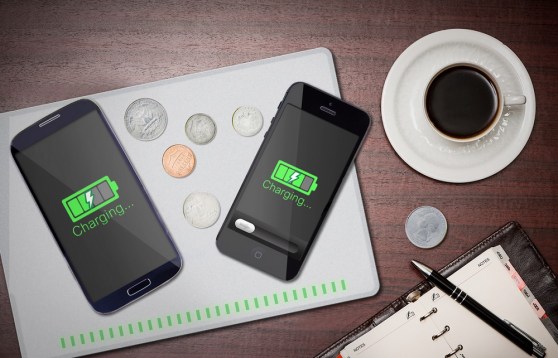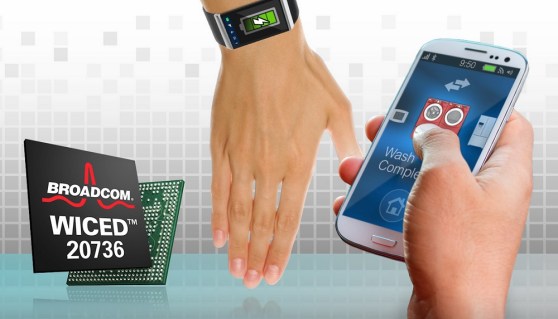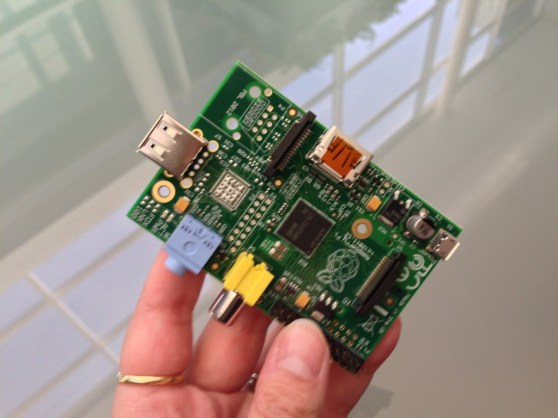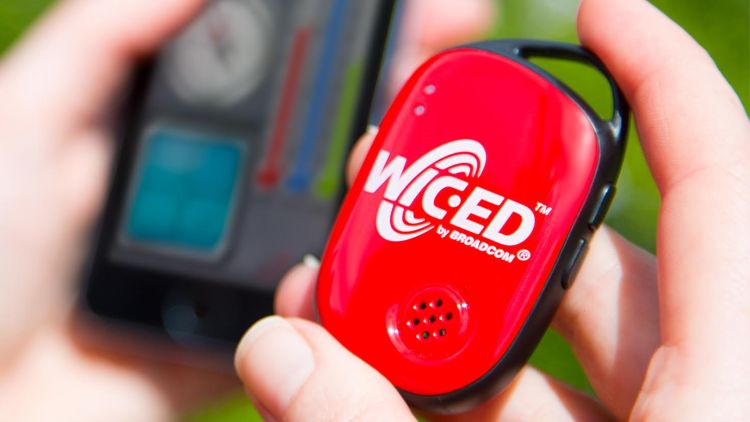
Above: Broadcom wireless charging
VB: That requires different silicon?
McGregor: Different silicon, different range. Often those are plugged in. The power characteristics are different. The bandwidth is different. The wearables are going to be about sensing or about I/O – visible displays or buttons or things like that. They interact with humans. The internet of things interacts more with devices.
VB: A couple of solutions are coming where you don’t have to replace batteries.
McGregor: They harvest energy or whatever, yeah. It would be very simple to do a version of this and put a solar cell on it. They use very little power. A combination of a solar cell and a tiny ultra-capacitor, probably ambient light is enough for many applications.
VB: That makes them disposable. Is that the way to go for a lot of things?
McGregor: For some things they’ll be disposable. A great example of that is what’s called a pill camera. For diagnostic purposes, people will swallow a device that has Bluetooth and a camera in it, with a little LED light, and it goes through your GI tract. That would be disposable. But a lot of them, if you can make them reusable it’s fine. It’s just a cost question.
If you go to a hospital right now and they put a cardiac monitor on you, they stick all these things all over your chest, and that connects to this big wiring harness that goes to a tree. That goes to all the monitoring equipment. If you want to go to the bathroom or go get some fresh air, you have to haul this tree and all the equipment with you. That’s dumb. Why not put little wireless tags on these things? It frees the patient to move around, and they don’t have to re-use a wiring harness that’s been exposed to a guy with a staph infection. Why not use sterile disposable tags for this? You can make that easily work.
VB: What do you see generating more interest or large chip markets?
McGregor: I see so many things. It’s all in this feedback loop cycle. The cost of wearables and the amount of data they create and the data being created by the internet of things and cameras—We can drive the build materials of an internet-connected camera down to five dollars or less. If you could buy cameras for $10 or $20, you’d sprinkle them all over. If you want to see how your cat’s doing when you’re away, why not? Or your plants when someone’s watering the plants. If you want to see if your kids are studying, put a camera up there. That’s going to generate incredible video traffic on the web. Security cameras are going to be a huge opportunity for all kinds of applications, and also for generating web traffic. That’s going to sell more of these for cameras and more of these for data.
VB: So the end-to-end strategy is what you guys have now?
McGregor: Our view is, we’re a communications company. We do everything to do with communications. From the original devices that connect to humans or sensors or whatever, all the way through the infrastructure side. We’re the plumbers of the internet, a bit. We do all the pipes and connections and stuff like that.

Above: Broadcom and the internet of things
VB: There’s all this competition in the space. Everybody’s announcing different internet of things processors. How do you assess that?
McGregor: If you announce an internet of things processor, you’ve already lost. Internet of things will be one device. It has to do all the wireless connectivity and power management and processing and sensor hub. If that’s not on one chip, you’ve probably already lost.
VB: So then an internet of things SOC or something?
McGregor: It’s a perfect SOC market, yeah. That’s a core strength of our company. We have all the pieces. The good news is that it’s such a big opportunity. There are so many new things out there. It’ll shake out over time.
The people who are going to win are the ones who can create complete solutions at super low cost, super low power. Form factor is a big issue. People want to make these things tiny. Whoever can do best at those things will succeed. That’s what we do.
VB: You guys are engaging with the hardware hobbyists somewhat. How’s that going?
McGregor: It’s going well. Our first engagement was the Raspberry Pi. We worked with a foundation in the U.K. and the goal was to put computing in the hands of every person. If you could afford a $25 or $35 computer, you wouldn’t worry that you broke it. You wouldn’t take your laptop apart to hack it, because it’s not very friendly inside. We wanted to make that market work.
The Raspberry Pi Foundation has done a tremendous job creating an ecosystem around that and getting people interested. A lot of people are now creating the do-it-yourself market. A lot of 3D printers are based on Raspberry Pi. All kinds of stuff is getting based on Raspberry Pi.
We see this WICED Sense as the next step in that. Raspberry Pi is aimed at people who want to do computing and video processing. This is aimed at people who want to create wearable devices.
VB: How are you going to measure the success there? The number of developers using an API?
McGregor: Our goal is not to make a lot of money on this device. This is a development kit. Our goal is for people to get this and have it inspire them to create a device, and ideally use some of our chips when they create it. That’s our motivation. Just to lower that barrier and make it really easy to do.
Typically a small company gets stuck on things like FCC certification. That takes some expertise and it’s a pain. We eliminate that issue. As long as you use that module you’re good. Integration of sensors, that’s hard. Just putting together the whole system. I think anybody who’s programmed or done other things, it’s so much easier to start with something that works and modify it to be what you want it to be, rather than have a bag of parts and start from scratch.
This is a complete working solution. You get all the hardware and all the source code, the manufacturing Gerbers, the build materials list, everything. You could instantly start manufacturing this exactly as it is, or you could start making changes to it and create your own product.

Above: Raspberry Pi
VB: Have you thought about getting your own engineers to do this?
McGregor: Funny that you mention that. About a week or so ago I announced that every employee at Broadcom is going to get one of these for their personal hacking. We’ll have some hackathons inside Broadcom. We’re going to give those applications that people create to our customers and inspire them, inspire the do-it-yourself market, and maybe one of those becomes a big business.
VB: Intel has gone to the extent of creating this new products division that has product designers. They expect to launch Intel-branded products.
McGregor: I don’t agree with that. Competing with your customers is not a good strategy. Our goal is to enable customers, not compete with them.
VB: If it’s more in the hardware hobbyist space, though, is that something that’s just plain fun for your employees to do?
McGregor: Absolutely, but a lot of stuff starts in the hobbyist space. GoPro started as a hobbyist project, because a couple of guys liked to do extreme sports. That’s a billion-dollar business today. I’m reluctant to diss something as a hobbyist thing, because quite often that’s the genesis of a big business.

